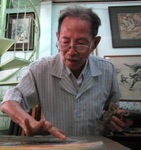Copyright © 1986-2016, Witness Collection and other copyright holders. All rights reserved.
Images and content on this site may not be reproduced in any form without prior written consent from Witness Collection.
For information about exhibitions, loans, internships or other forms of collaboration, please email us via the contact us page.

Tú Duyên passed away on 3 May 2012.
Asiarta Foundation will soon publish a comprehensive book on Tú Duyên’s life and works.
Tú Duyên
